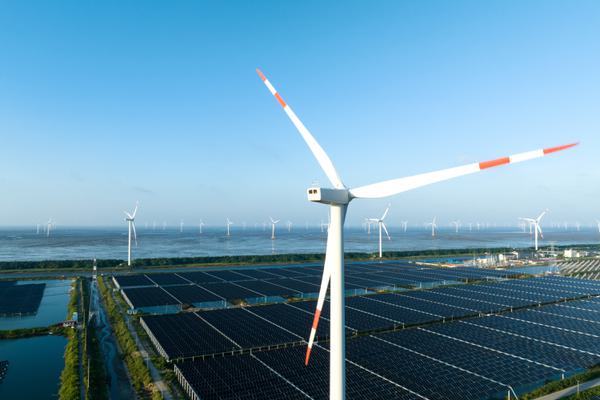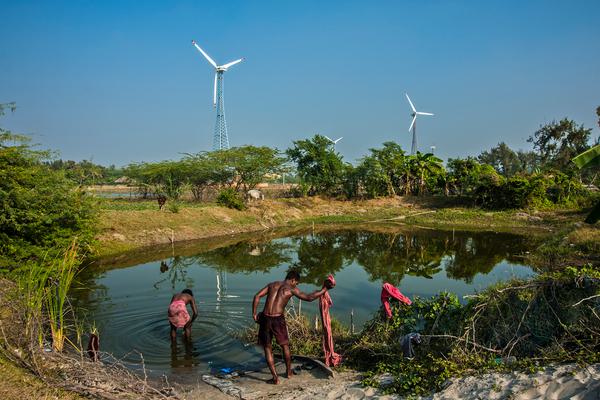A Just Transition for Communities: Can Wind and Solar Projects Turn Human Rights Lessons into Leadership?
9 August 2022

Land acquisition without consent or compensation. Loss of cultural identity and traditions. Threats and violence against human rights defenders. These are just some of the human rights impacts Indigenous Peoples and other local communities face, among over 200 allegations against the renewable energy industry over the last decade as recorded by the Business and Human Rights Resource Centre. The unlikely source of nearly half of these? Wind and solar projects.
The wind and solar sectors are booming, and for good reason. They are the cornerstone of the global race to meet Intergovernmental Panel on Climate Change emissions targets and advance access to affordable energy in line with the Sustainable Development Goals. Dig a little deeper, however, and a more troubling picture emerges.
Human rights impacts in wind and solar value chains like child labor in transition mineral extraction, forced labor in polysilicon manufacturing, and public health impacts from the disposal of solar panels and wind turbines, have all made headlines. Equally important, are human rights impacts to Indigenous Peoples and other vulnerable communities on the front lines during wind and solar project deployment (including a project’s development, construction, and ongoing operation).
In short, wind and solar projects have a human rights problem. But they don’t have to. In fact, addressing these often-overlooked community impacts is crucial for the sector to course-correct and grow in a rights-respecting way.
The land-project nexus: a perfect storm for adverse community impacts
The global installed capacity of renewable energy is forecast to expand 60% by 2026, with wind and solar leading this growth. This trend, coupled with the land-intensive nature of wind and solar projects, foreshadows a worrying parallel trajectory for adverse human rights impacts to communities near these sites. Five of the seven countries forecast to attract the most wind energy projects alone – China, India, Brazil, Turkey, and Mexico – score ‘high’ or ‘extreme’ on risk indices related to Indigenous Peoples’ rights, land rights, and violations by security personnel. This perfect storm of rapid growth, land-intensity, country risk profiles, and rising human rights allegations has community impacts set to take centre stage unless something changes. And it’s not just communities that are at risk.
Risks for wind and solar projects, companies, and the sector
Beyond causing widespread, often irreversible harm to people and communities, human rights harms are also bad news for companies. Community protests, adverse media coverage and investor pressure – these cascading responses all translate to operational, financial, and reputational risks for wind and solar projects through project delays and cancellations, abandoned assets, diminished return on investment, and an inability to secure or retain finance. Case in point: In Oaxaca, Mexico, Mareña Renovables was forced to abandon and relocate a $1.2 billion 132-turbine wind project that interfered with traditional fishing practices and cultural rituals, following community roadblocks, complaints, and litigation.
Legal risks are also significant, particularly given the emerging landscape of mandatory human rights due diligence laws. France’s largest utility, Électricité de France (EDF), is facing a lawsuit for failing to conduct adequate due diligence in relation to its Mexican wind farm project, resulting in a violation of the rights of the Indigenous Zapotec community of Unión Hidalgo. Meanwhile, courts in Kenya and Norway have nullified project land title deeds and revoked operating licenses because land was acquired without the free, prior and informed consent and compensation of Indigenous Peoples and interfered with traditional grazing rights.
And it isn’t just renewable energy companies that are on the hook. Companies in other sectors are increasingly diversifying into the wind and solar business or launching ad hoc wind and solar projects to supply their operations. In April, tech giant Amazon announced a bundle of new wind and solar projects bringing its global total to 310 across 19 countries, 134 of which are not just rooftop installations, but fully-fledged wind and solar farms. Similarly, IKEA’s parent company, Ingka Group, operates 547 wind turbines and 10 solar farms across 15 countries and has begun on-selling electricity to households in Sweden.
The implications of this trend extend well beyond the project and company level. Look no further than the fossil fuel industry to see how poor human rights and environmental records can lead to investor skepticism, threaten market growth opportunities, and undermine a sector’s public support and legitimacy. Should renewable energy repeat these mistakes, the stakes are particularly high. Pursuit of a just transition doesn’t just safeguard human rights; it also safeguards the long-term viability of this sector and with it, a speedy and successful trajectory toward 2050 climate goals.
The equation is simple: If wind and solar are undermined, so is our path to net zero. A just transition doesn’t delay climate action, it enables it.
The way forward
The next few years present a critical window of opportunity for wind and solar projects to improve their human rights performance before poor practices become entrenched. And preventing and mitigating adverse community impacts during deployment are a crucial focus on the path to course-correction. The pressing question is: what can wind and solar projects do in practice to address these issues?
The UN Guiding Principles on Business and Human Rights (UNGPs) are an established global standard affirming state duties to protect against abuses involving private actors, and setting expected standards of corporate human rights due diligence. Recent human rights and just transition benchmarks found that wind and solar companies scored poorly in their implementation of the UNGPs and lacked policies on some of the most salient human rights risks during deployment – including land rights, the human rights of Indigenous Peoples’ and local communities, and protection of human rights defenders.
To bridge this gap, the Columbia Center on Sustainable Investment recently launched two new resources – a business guide and legal primer – that draw on the UNGPs to provide all companies involved in wind and solar projects with guidance to address community-related impacts during deployment. These resources offer a succinct snapshot of why this issue is important for companies, which human rights impacts are most common and salient, and the business case for addressing these in terms of legal, financial, operational, and reputational risks. They also provide companies with a list of actionable recommendations across four key areas – governance, policy commitments, partnerships, and due diligence, integration and remedy – as well as case studies where wind and solar companies are making progress on these issues. In Canada, for example, companies have deployed wind and solar projects in partnership with First Nations, Inuit and Métis communities such that these communities both participate in the projects and retain a share of the ownership and profits.
Wind and solar projects may have a human rights problem, but they also have an opportunity to turn these lessons into leadership to drive an energy transition that is both fast and fair.



